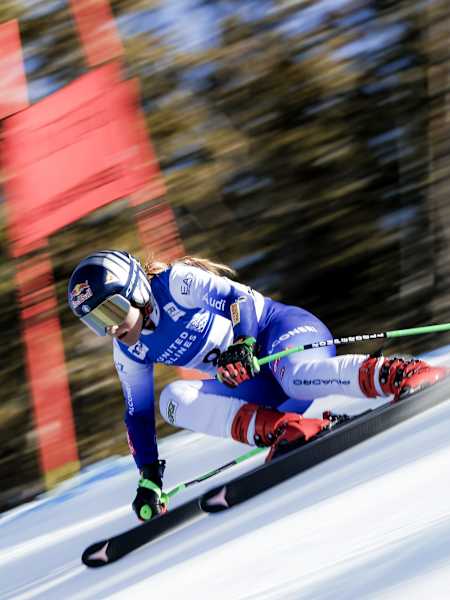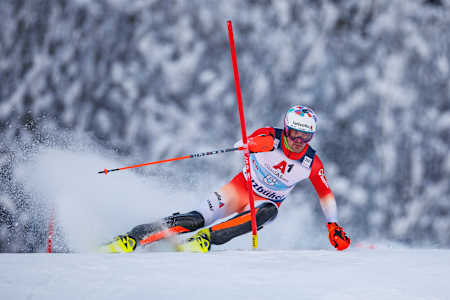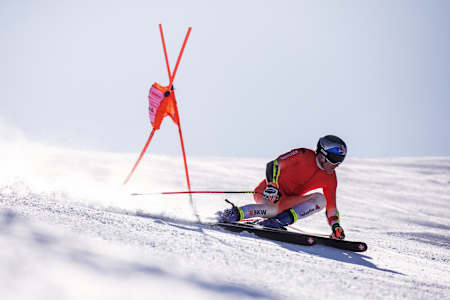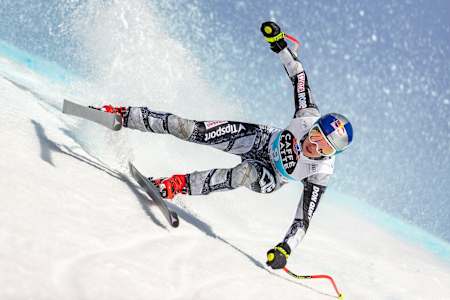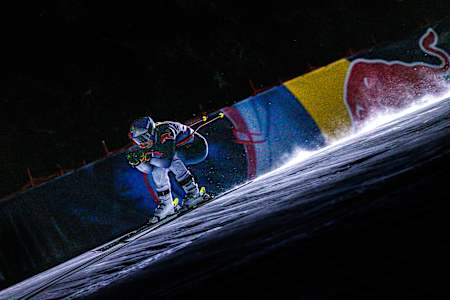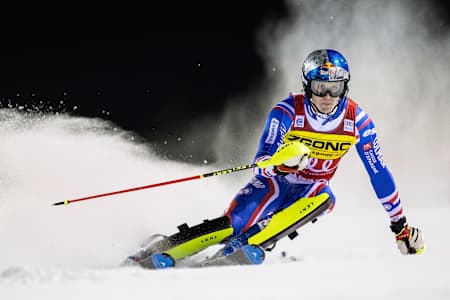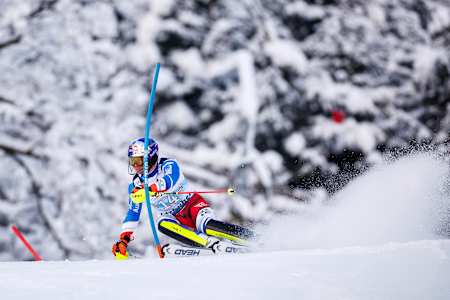Wintersports
All ski racers have two boards under their feet and ski down a steep piste with gates - but that's all the alpine ski disciplines have in common. In the World Cup, World Championships and Winter Olympics, races are now held in six disciplines, which are divided into technical and speed disciplines. The former include the slalom and the giant slalom, while the latter include the downhill and the super-G. There are also parallel competitions and the combination.
The course is marked with red and blue gates for all formats. With the exception of the slalom, where individual poles with tilting technology are used, a gate always consists of two poles with a kind of flag between them. The racers have to drive round these gates in a specified order and on the correct side, otherwise they will be disqualified.
We'll start with the two technical disciplines slalom and giant slalom - and get faster with each discipline!
01
The slalom
Technique plays the main role in the slalom. It is the slowest discipline in skiing, and there is a simple reason for this: the gates follow each other more closely than in any other format. This requires frequent changes of direction so that the athletes cannot simply let their skis run and are slowed down by the numerous bends. Nevertheless, it is a spectacular and exciting discipline, as tens of thousands of spectators prove, for example, at the annual night race in Schladming.
Characteristics of the slalom:
- The racers ski very close to the poles and knock them away with their hands or shins in order to stay in the fastest 'fall line' as much as possible.
- Spring-mounted tilting poles are used to minimise the risk of injury.
- Skiers complete two runs in during each race and the course is set differently for the second run.
- Only the top 30 fastest skiers from the first run qualify for the second run. They then start in reverse order; i.e. slowest goes first.
- The rider with the fastest total time across both runs is the winner.
- The distance from one pole to the next must be no less than 6m and no more than 13m.
- The vertical drop is between 180m and 220m for men's races and between 140m and 200m for women's events.
- The slope gradient should be between 33% and 45%.
- Best-known races: Schladming and Kitzbühel in Austria.
Get to know rising slalom star Zrinka Ljutić in the episode of Winter Heroes below:

17 min
Zrinka Ljutić
This powerful skier is only the second Croatian woman in history to claim a World Cup Crystal Globe.
02
Giant slalom
In the giant slalom, skiers descend the mountain at a higher speed as there are fewer gates and they are further apart than in the slalom. This means that the skier has to make fewer turns. Nevertheless, perfect skiing and cornering technique is of great importance: standing well on the edges and making the right turns is the be-all and end-all for staying ahead.
Characteristics of the giant slalom:
- Athletes ski further away from the gates than in slalom and, if at all, push them away with their shoulder rather than their hand.
- The gates are stiffer and less forgiving than in slalom.
- The racers complete two runs in one day, with the course set differently for the second run.
- Only the top 30 from the first run qualify for the second run, when they start in reverse order.
- The rider with the fastest total time in both heats is the winner.
- The distance from one gate to the next must be at least 10m.
- The altitude drop is between 250m and 450m for men, and between 250m and 400m for women.
- No specific gradient is prescribed, but the terrain is normally undulating and the course should be around 40m wide.
- Best-known races: Adelboden in Switzerland and Alta Badia in Italy.
Meet Winter Hero and giant slalom specialist Alice Robinson below:

14 min
Alice Robinson
With explosive and unpredictable runs, Alice Robinson is putting New Zealand on the podium in alpine skiing.
03
The Super-G
The Super-G is one of the newer World Cup disciplines straddles the gap between downhill and giant slalom. The first World Cup Super-G race took place in 1982 and the word is an abbreviation of Super Giant Slalom.
Characteristics of the Super-G:
- List
- Racers only complete one run.
- There's no training on the course allowed beforehand, only one course inspection.
- The distance from one gate to the next must be at least 25m.
- The altitude drop is between 400m and 650m for the men and between 400m and 600m for the women.
- The terrain should be undulating and hilly, and the course should be approximately 30m wide.
- Best-known races: Cortina d'Ampezzo in Italy and Beaver Creek in the United States.
04
The downhill
For many, the downhill is the supreme discipline in alpine skiing. In addition to muscle-bound thighs, it really does take a lot of courage to hurtle down the mountain at speeds of up to 160 km/h, as on the Lauberhorn in Wengen. In addition, there are meter-wide jumps that make the races particularly spectacular. Because as the FIS itself so beautifully defines it: "A downhill run is determined by the six components of technique, courage, speed, risk, physical condition and judgement."
Characteristics of the downhill:
- Riders only complete one run.
- At least one training run is completed on the course beforehand.
- The distance from one gate to the next must be at least 25m.
- The altitude drop is between 750m and 1,100m for men's races and between 450m and 800m for women's events.
- The course must be able to be skiedat different speeds from start to finish and be approximately 30m wide.
- Best-known races: Kitzbühel's Strief in Austria, Wengen in Switzerland, Italy's Val Gardena and Bormio, Garmisch-Partenkirchen in Germany.
05
The combined
Who is the most versatile or most complete skier? An exciting question that will be decided in the combined competition. Because both technique and speed are required here. In this format, the all-rounders complete two runs. The first is a downhill run or a super-G - so it's all about letting the skis run and plunging down a steep course with only a few gates as bravely as possible. The second run then takes place on a slalom course - narrow, with lots of gates, where the technique has to be right in order to reach the finish line as quickly as possible. In the end, victory is decided by adding up the times from both runs.
Features of the combination:
- The racers do two runs: first on a downhill or Super-G course, then on a slalom course.
- The technical rules of the slalom, downhill and Super-G apply.
- The FIS provides for three formats: the Alpine Combined, the Classic Combined and special forms.
- In the classic combined, the speed run is always a downhill, while in the alpine combined it's either a downhill or Super-G.
- As part of the special forms, competitions are permitted that consist of combinations of either three or four competitions in the disciplines of slalom, giant slalom, Super-G and downhill.
- The FIS can even authorise competitions that combine one or more of the four ski disciplines mentioned with competitions in Nordic skiing, swimming or sailing.
Find out more about the combined with Winter Hero and skiing legend Marcel Hirscher:

11 min
Marcel Hirscher
Arguably the best male ski racer has returned from retirement to attempt the mother of all comebacks.
06
Parallel races
In parallel competitions, which can be held as a parallel slalom or parallel giant slalom, skiers duel simultaneously on two courses that are as identical as possible and located next to each other. The layout and preparation of the snow should match as closely as possible to ensure a fair competition. This is also ensured by the rule that the athletes complete two runs man against man and swap courses in the second run - so if skier A competes on the blue course in the first run, he skis the red course in the second run.
Features of the parallel competitions:
- The course drop should be between 80m and 100m.
- The courses should have 20 to 30 gates.
- The running time should be between 20 and 25 seconds.
- A maximum of 32 riders compete against each other in the final round. If more are entered, qualifying runs against the clock will take place beforehand.
- The knockout format applies: i.e. the rider with the faster overall time from both heats advances to the next round.

